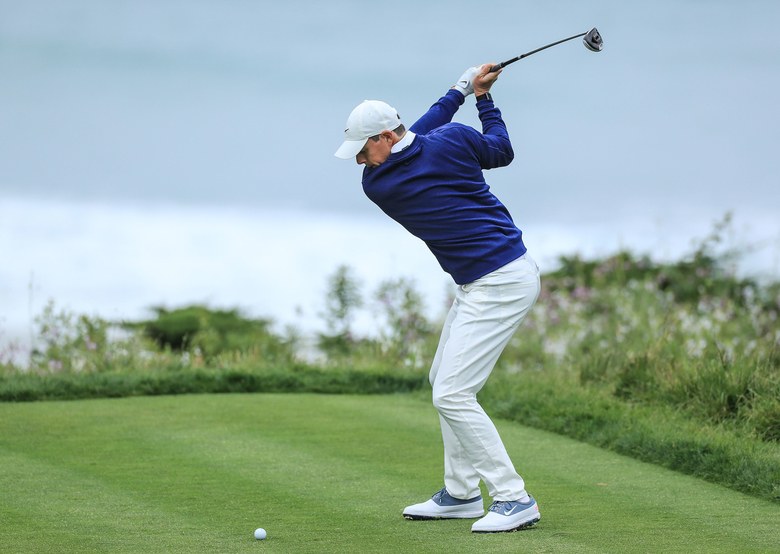David Cannon/Getty Images
Rory McIlroy plays his tee shot on the par-4 11th hole during the first round of the 2019 U.S.Open.
By Brian Wacker
PEBBLE BEACH, Calif. — A year ago, Rory McIlroy arrived at the U.S. Open at Shinnecock Hills a couple of weeks early, soaking in the gilded golf landscape of eastern Long Island with casual games at National Golf Links, Maidstone, Friars Head and Garden City, among others. Who could blame him given the siren song of some of the finest turf anywhere in the world?
But after missed cuts at each of the last three U.S. Opens, the 30-year-old Northern Irishman took a different approach to his prep this year. Rather than roll into the Monterey Peninsula early to grind at Pebble Beach, or spend a couple of sun-splashed and unusually warm afternoons pegging it up at the property’s holy grail, Cypress Point, he instead opted for the test of tournament golf at the Memorial and then the RBC Canadian Open.
The decision netted McIlroy his second victory of the season as he scorched Hamilton Golf & Country Club last week with a final-round 61 to turn a three-shot lead at the start of the day into a seven-stroke blowout.
Thursday morning at Pebble Beach, with a cool marine layer hanging overhead and the course playing as soft and benign as it likely will all week, he kept the good vibes going with a three-under 68 to sit just two strokes off the lead in the year’s third major.
There were a few chances that slipped though McIlroy’s hands that would have taken his score even lower, but it was also his first opening round in the 60s in a U.S. Open since 2015 at Chambers Bay. He was happy to take it.
“I think the comfort level in my game is still there,” he said of the momentum that he carried across the border from Canada. “I saw really good shots last week, not maybe under pressure, but in a situation where I needed to hit good shots. And I was able to do that and that breeds confidence.”
RELATED: Rory’s recent major woes have more to do with bad starts than bad finishes
That was evident early on and throughout the round.
After blowing his approach into a greenside bunker and failing to get up-and-down on his opening hole of the day, the difficult par-4 10th, McIlroy was hardly fazed, saving par with a testy six-footer on 12 before sticking his approach on 13 to 10 feet to set up his first birdie of the morning.
Then came another at the majestic 17th, where McIlroy stuck his tee shot just inside 10 feet, pin high left of the flag.
“I think this golf course has a really good flow to it whenever you do tee off 10,” he said. “You can get a little bit of momentum going if you play well.”

Warren Little/Getty Images
McIlroy plays a second shot on the 10th hole during Thursday’s first round.
That momentum, from last week and from his first nine holes, came in handy on the front nine at Pebble, too, with McIlroy draining a 12-footer for birdie on the second followed by a 22-footer on the third, where ball spun around the hole before falling in.
Even when things didn’t go his way, they did.
At the fifth, McIlroy flubbed his greenside chip and the ball stayed on the shaved area short of the fringe. No problem. He rolled in the 24-footer to save par. On the par-4 eighth, his approach sailed long leaving a delicate chip, but McIlroy stopped the ball six feet from the hole and made the putt.
There were missed birdie chances, like the 10-footer he faced on his closing hole, the ninth, among others, but that happens. In the end, it was the kind of good start that McIlroy, whose last major victory came five years ago at the 2014 PGA, has longed for and a point that was driven home by another U.S. Open winner, Johnny Miller, earlier this week at the tournament’s Champions Dinner.
The other key piece of information gleaned from that gathering came from the chatter with McIlroy’s tablemates, two-time defending champion Brooks Koepka and 2015 winner Jordan Spieth, on how to dissect the seaside layout, which has some of the smallest greens in tournament golf anywhere.
“The unanimous decision was if you hit the middle of the greens all week, you’re not going far wrong,” McIlroy said. “Just keep it in the fairways and keep hitting greens, and you’re going to be OK.”
Staying competitive apparently works OK for McIlroy, too.
“Yeah, I could have came here last week and played this golf course to death,” he said of the difference. “But it wouldn’t have done me any good. I needed previous experience with that to teach me that. I don’t think there’s any substitute for getting a card and a pencil in your hand and going out and trying to shoot a score under tournament conditions.”









